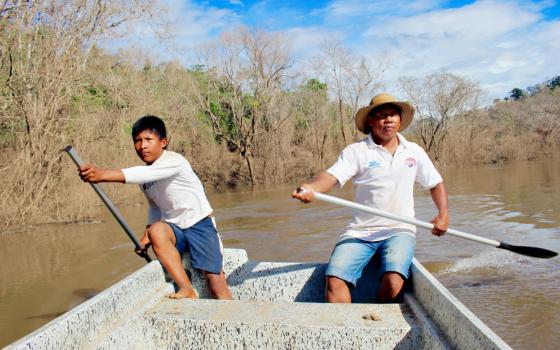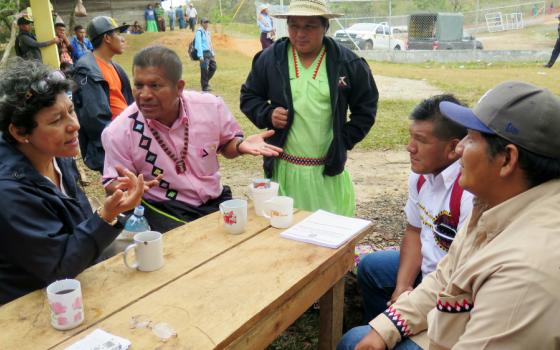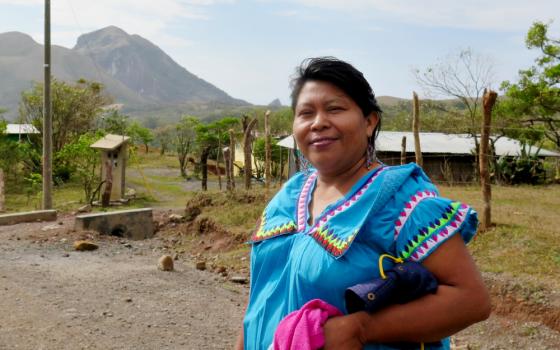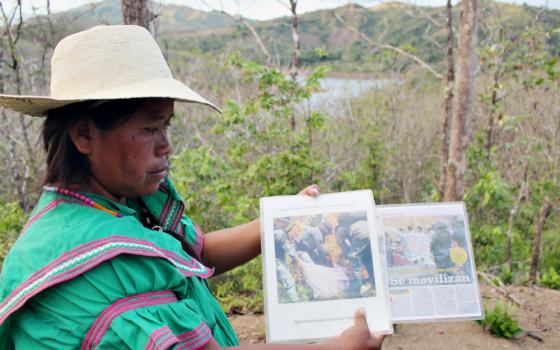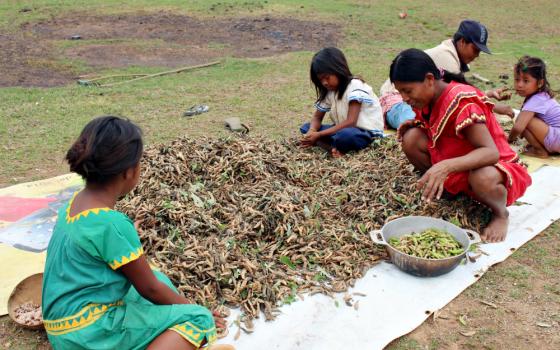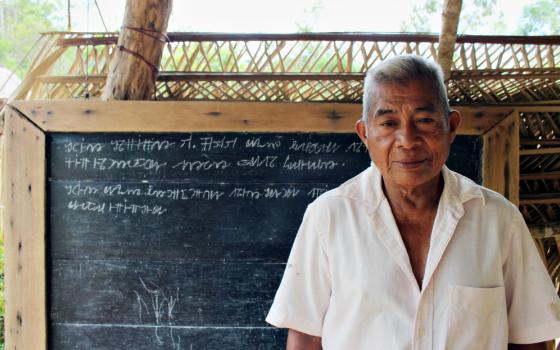Kiad, Ngäbe-Buglé Comarca, Panama - "Bulu Bagama is my positive name. Luis Jiménez, my negative one," the Ngäbe elder began, standing on an expanse of cracked mud that covered what for generations was his family patrimony. A tumbledown shell of a house lay in ruins, and a few dead leaves clinging to one remaining tree provided scant shade from the sweltering midday sun.
The words, referring to his indigenous name and the one imposed by the dominant Spanish culture, summed up the feelings of betrayal from a people that has fought bitterly for nearly two decades to stop the Barro Blanco dam, a hydroelectric project that to local communities and environmentalists has become a symbol of everything that's wrong with the current model of development in Panama.
Bulu and his wife, Adelaida González, stood in the mud and recalled that terrible night last August when they awoke to find the waters of their sacred Tabasará River seeping into their home. They scrambled to collect their children and as many of their possessions as possible. Neighbors weren't so lucky; their houses were completely washed downstream. A child narrowly escaped drowning in those harrowing hours.
They had been given no warning, he said, and since negotiations with the government and dam builder were ongoing, the family had thought they were safe. The affected communities of Kiad, Nuevo Palomar, Quebrada de Caña and Quebrada de Plata weren't consulted about the flooding of their lands, they say, which directly affects around 500 people but also has an important impact on the entire Ngäbe-Buglé Comarca, an autonomous territory that is home to more than 150,000 individuals of the Ngäbe and Buglé indigenous groups. The Tabasará River in itself is sacred for them, as is the ceremonial site that is now submerged.
Despite the years of fierce resistance, the dam was built downstream, and last May the reservoir began to fill. Now the residents of the flooded communities are just asking that the water level be brought down to the boundary of their territory, consistent with the law.
Kiad is an important cultural and ceremonial center for the Ngäbe; there along the river lay two sets of ancient petroglyphs that contain the clues to the wisdom of their ancestors. The boulders are now completely submerged, cutting off their connection to their past.
The Honduras-based company Genisa said it was conducting a "test flooding" of an area that, according to its environmental impact statement, was uninhabited. Just another deception, opponents claim, in a long line of them, including carbon-credit certification under the Clean Development Mechanism (CDM), a program designed under the Kyoto Protocols to allow industrialized countries to "offset" their greenhouse gas emissions by supporting sustainable development projects in less-developed countries.
International human rights and environmental groups have maintained that Barro Blanco was anything but sustainable, and that the history of human rights violations associated with the dam project should make it ineligible. Finally, the Panamanian government withdrew the CDM registration last November — a first for the CDM program.
"The tactics this company used were pretty much what all companies have used — falsifying studies, not doing interviews or doing them far from the affected communities," said Fr. Joe Fitzgerald, a member of the Vincentian community of Soloy who has ministered to the Ngäbe people in the region for 12 years.
"Genisa has been horrible in their whole treatment of the situation."
The project was temporarily suspended in part for noncompliance with the environmental impact assessment, but the suspension was eventually withdrawn and the project continued.
Genisa, contacted by telephone and Twitter, has not responded to requests for an interview.
The flooding was a bitter anticlimax to a battle that has incited thousands across the country to take to the streets, and the government to go to extreme measures to ensure the dam's completion.
Barro Blanco is just one of more than 30 dams that have been built, with dozens more proposed or underway in Panama, and it is far from the largest, at a generating capacity of just 28 kilowatts and an affected territory of fewer than 18 hectares. Severe police repression against the mostly indigenous protesters has drawn fire from the international community, and on March 17 the case was one of several heard by the Inter-American Commission on Human Rights in Washington, D.C. (See related story.)
"They know it's a minor project," said Osvaldo Jordán, executive director of the Panamanian nonprofit Alianza para Conservación y Desarrollo (Alliance for Conservation and Development), one of the groups that requested the hearing. "If there was a functioning rule of law in this country, it would have been canceled long ago. However, there is a symbolic element that the government did not want to allow to happen ... which is that a group of people would take a firm position without major resources and make a project like this go down."
A sister's role
At its peak in 2011, and again in 2012, the battle to stop the dam effectively shut down commerce in the western part of the country, as thousands of Ngäbe protestors and their allies blocked the Pan-American Highway. Mercy Sr. Edia López was among them.
"I came into the area just to ask for a service job as a missionary with the poorest population of the country, without realizing that they were facing a very big problem with land and water," said López, known as "Hermana Tita" throughout Chiriquí province. A native of Chiriquí, she has been working in the comarca since 2010, when she moved from another district near the Costa Rica border. A small, animated woman with an easy laugh and a quick wit, she has witnessed the severe police repression that has occurred. She was moved to tears as she recalled seeing several indigenous activists injured in clashes.
Long before Pope Francis released "Laudato Sí, on Care for Our Common Home," López was focused on land and water issues. "I was always interested in the struggle before the pope's call and had a passion for the matter of caring for the common home, and I became involved in the mining struggle of the indigenous population and the local leaders," she said. "It was a tremendous struggle."
In the beginning, the fights against the mining and against the hydroelectric dams were linked, she said. The movement won a victory with a law to stop international investment in the mining industry in 2011 and with a new law to prohibit mining in the comarca in 2012. But a growing number of hydroelectric dams were still underway, including Barro Blanco, and the fight went on.
"I honestly didn't know what to do, but there we were in the streets, in the protests, and in meetings with the leaders, the coordinators, the grassroots leaders," López said. She found herself helping with logistics, with mediation with government leaders and police — roles that were beyond anything she'd imagined, but it was what needed to be done, and so she did it.
"I was just a witness, a logistical support, a moral support, a spiritual support, a friend of the leaders. I supported in any way I could."
Dead forest
The Jiménez family lost everything they owned in that flood. Bulu's anguish turned to rage as he recounted all that his family has lost, and then related the way the government first denied his people's existence, and then tried to buy them off.
Just upstream, the Miranda family also struggles with the loss of their river and their farmland, and continue what looks to be a losing battle to maintain their homes and way of life.
Göejet Miranda's face was grim as he dipped the paddle into the cloudy, foul-smelling waters of the Barro Blanco dam reservoir through a corridor of death — grand old trees that once shaded a clear, free-flowing river now gray skeletons against a dry blue sky. The trees had provided essential food for a wide variety of fish and freshwater shrimp that were a big source of people's livelihood, said Miranda; most of the fish species have died out since the dam began operating, and the shrimp as well.
He docked the boat and clambered out onto the mud alongside the dead remains of what modern agroforesters would have called a diverse food forest, which the community had cultivated for generations. Once, it had produced a life of abundance — mangos, bananas, papayas, quince, oranges, pineapple, cacao, coffee, yams, beans, corn and much more were their main source of income as well as food. More than 40 types of medicinal herbs that served as a natural pharmacopoeia now lay under a thick layer of mud.
The Miranda family compound is on higher ground than the Jiménez's, so water has not yet reached their homes. At the heart of their land is the cultural and educational center where their father, Manolo Miranda, developed the written form of Ngäbere, the language of the Ngäbe people. The reservoir now cuts off the village of Kiad and the educational center from the rest of the world — what was once less than an hour's walk to the closest town is now two hours.
Miranda's sister Weni Bagama is a leader of the April 10 Movement — the first of two different Ngäbe movements aimed at stopping the dam — and a deputy of the Ngäbe-Buglé General Congress, as is Miranda. She struggles to cope with the loss of their spring-fed river, where they bathed three times a day and washed their clothes and played — now a stinking mosquito breeding ground surrounded by acres of mud. She trudged uphill to their only source of clean water, a trickle from a spring uphill. As of early March, the waters had dropped enough to reveal the devastation of what had been their food forest. Now they were enduring a dry season hotter than any they remember, fearful of a rainy season and a rise in the waters that may spell the end of their lives in Kiad.
At the encampment
López is a frequent visitor to the encampment of the September 22 Movement, which lies along the Panamerican Highway, next to the entrance to the office of Genisa. She arrived just in time for the sunset prayer service and headed down the embankment into a rough-hewed settlement among the sparse trees. Some 30 practitioners of the Mama Tatda religion, practiced by a majority of Ngäbe, gathered under the palm-roofed shelter that serves as the encampment's church. Their haunting voices rose in the falling light as they sang and prayed in their native Ngäbere.
Their leader is Clementina Pérez Jiménez, a fiercely spiritual woman who paints her face before she goes into battle. Besides being a local chief, Clementina is national coordinator of the September 22 spiritual protest movement, named for the date in 1962 when their prophet, a woman named Besiko, had a vision that exhorts them to leave behind the modern materialist lifestyle and to protect the Earth and their cultural traditions.
"The Blessed Virgin said clearly that if the Barro Blanco project is not canceled, there will be disaster in the world," warned Clementina, 43, who was just 15 when she joined the student movement. She was the leader of the encampment in front of the entrance to the dam last May when police sent riot squads to forcibly remove them. She has laminated copies of the newspaper articles dated May 25, 2016, that show a cluster of police surrounding and grabbing her as she lay in front of the machinery, prone in her traditional white nagua dress.
"We have to respect the life of nature, in order to have the peace of God, because if we do not respect the legal norms of the life of God on Earth, then we cannot exist in the world," she told me earnestly. "It is clearly stated, 'If the indigenous peoples are beaten, the water will dry up or it will become blood.' We do not want that to happen with the peoples of America or any other people."
Police repression reached a climax under former President Ricardo Martinelli, 2009-2014, when hundreds of indigenous protesters were injured and several were killed. Current President Juan Carlos Varela sought a softer image and initially promised to cancel the dam, and began 12 months of negotiations with the Ngäbe leaders.
Eventually, however, he switched sides and persuaded the current chief of the comarca, Silvia Carrera, to sign an agreement last August allowing the nearly finished dam to proceed in exchange for certain goods and services for the comarca.
A celebration soured
Llano Tugrí, the capital of the comarca, is a remote, wind-beaten outpost among the peaks of the Cordillera Central, reached in a more-than-two-hour, white-knuckled ride in a pickup with 15 people in the back, sitting on wooden benches.
Among them was the dignified Ngäbe deputy and dam opponent Weni Bagama. The group was heading to the capital to celebrate the 20th anniversary of the comarca. They arrived at midnight and slept a few hours in a rustic shelter. Despite the buffeting winds and cold temperatures, Weni awoke early to bathe in the river, a treasured ritual no longer possible in her own beloved Tabasará. She emerged glowing and resplendent in her bright blue nagua dress, ready to face the day.
She had waited for today to do her interview, in the capital of the comarca on its 20th anniversary, to emphasize her point. The creation of the comarca was gained after years of struggle, giving the Ngäbe people authority over their own lands. Barro Blanco is in clear violation of that law, Weni said, as well as a number of others, national and international, which she enumerated, and its presence threatens the integrity of the comarca.
"The government makes it seem like this is a great thing, without taking into account the human rights that are being violated, without seeing that our homes are being flooded," she told me. "What we want to clarify to the public is that this wall was imposed upon us. When they began this project, it began with the intervention of the police. The public forum was held with police. When they built the walls, it was with the police. Every step of the process was imposed by the police."
What the April 10 Movement is asking for now, she said, is that the reservoir levels be lowered to below the limits of the Ngäbe territory. It's not enough to repair the damage or even the river, but it's a solution they can live with.
On a day dedicated to celebration, many present were in no mood to celebrate — partly because of Barro Blanco.
Carrera, the current cacica, or chief, surveyed the crowd from the back, serious and tired-looking under her broad-brimmed white hat. The Ngäbes' first woman cacique, she had been a strong voice at the forefront of the marches and the roadblocks. But something changed last August, when she signed the agreement with Varela there in the capital of Llano Tugrí. She was nearly thrown out of office afterward by her own people, who were furious about the agreement.
She continues to oppose the dam, she told GSR, and any other extractive project in the comarca. She only signed the agreement because the dam was done, and she felt it fell to her to negotiate some benefits for the comarca in exchange for their lost territory and ruined river: jobs for the people, a certain percentage of profits, goods and services. She ended up feeling bitter as her people opposed the agreement, the dam was finished and the comarca ended up with nothing but conflict.
"We learned when the Spaniards came and took our gold for mirrors," she said sadly. "The resources are our Mother Earth and they are ours to care for."
López is among those witnessing the potential of an even greater threat. One of the harshest impacts of the continuous pressure on Ngäbe authorities to open their resource-rich lands has been to intensify the fissures that open among the communities as deals are cut without community support. Ultimately, the interference has affected governability among the Ngäbe, she said.
Evidelio Adames, a biology professor at the University of Panama who grew up with the Ngäbe and has served as an investigator, witness and mediator throughout the conflict, agreed.
"They have their own wisdom, and they have the capacity to prevent such problems, but the government and the corporations are entangling them," he said. He traces the roots of the conflict to 2007, when the government opened bids to companies interested in building a hydroelectric plant on the Tabasará. "That auction was without consultation, and that was the first capital sin," he said. "Now cultural patterns have been affected, a watershed fragmented, and that impacts everything."
Back in Kiad, Manolo Miranda, brother of Weni and Göejet, sat on a hammock in the open-air schoolhouse and gently rocked back and forth, creating his own breeze as he reflected on the irony of a village without electricity being submerged by a hydroelectric dam. Kiad counts on one solar panel to charge its cellphones and computers; they have no need for hydro power.
It's been a tough fight, he said, and it's not over yet. But no matter what happens, he said, the battle against Barro Blanco has won more than it has lost.
He pointed to the success pressuring the Panamanian government to take away the company's capacity to issue carbon credits — thus far, it's the only case in the world where this has happened — and the embarrassing lobbying efforts against the Dutch and German development banks that helped to fund the project.
"We know that this struggle for justice has won. And we know that even if the project ends up operating in the end, it will do so with shame. What we've done, we've done with dignity and fairness.
"The eyes of the world are still on Barro Blanco. It has been an experience not only for the government, and for Panama, but it's been an experience for the corporations, and also for the financial institutions. And the resistance hasn't ended. The banks will see what happened at Barro Blanco and will apply this experience in other examples. This experience is absolutely not just for Panama, it's for the world."
[Tracy L. Barnett is an independent writer, editor and photographer specializing in environmental issues, indigenous rights and sustainable travel.]
Related - Listen to Tracy L. Barnett and GSR's Sr. Michele Morek in this NCR in Conversation podcast on the environment
Panama's hydroelectric boom destroys ecosystems, threatens rural way of life
Washington hearing is activists' last hope in battle over Panama dam
